- What is the Vicentina Route and why is it worth it?
- Historical Way: the rural interior of Alentejo
- Fishermen’s Trail: walking along the Atlantic
- Circular routes: half-day and full-day hikes
- Can you do the Vicentina Route by bike?
- Accommodation, transport and services for hikers
- Food and local culture along the route
- Practical safety and waymarking tips
- Best time to walk the Vicentina Route
- Vicentina Route: an unforgettable natural and cultural experience
The Vicentina Route is one of the best hiking destinations in Europe. Its more than 750 kilometres between Alentejo and the Algarve connect cliffs, wild beaches and rural villages where time moves slowly. If you are looking for an authentic, flexible experience close to nature, the Vicentina Route is the perfect place to walk, disconnect and discover the southwest of Portugal step by step.

Cape St. Vincent
What is the Vicentina Route and why is it worth it?
South of Lisbon, where the Atlantic bites cliffs and softens endless beaches, the Vicentina Route threads together paths that smell of salt, thyme and village chimneys. More than just a trail, it is a network: around 750 kilometres of paths between Alentejo and the Algarve, designed to travel on foot or by bike, at your own pace, unhurried and with the ocean almost always in view.
There are no Gothic cathedrals or big cities here. There are whitewashed villages with blue doors, dogs sleeping in the sun, cafés where time is measured in bicas and pastéis, and a coast whose mood changes several times a day: fog, wind, scorching sunshine, sunsets that paint the cliffs orange.
The Vicentina Route is worth it because:
- It combines wild coastline and rural countryside, without feeling like a theme park.
- It is well marked and designed for “normal” hikers, not just experts.
- It passes through villages that still live from fishing, farming and grazing.
- It is flexible: you can walk for a couple of days, a week, or link routes together like Lego pieces.
Two major protagonists structure the whole route: the Historical Way, which goes deep into rural Alentejo, and the Fishermen’s Trail, always next to the sea. Around them, a constellation of circular routes allows for spontaneous half-day or full-day escapes.
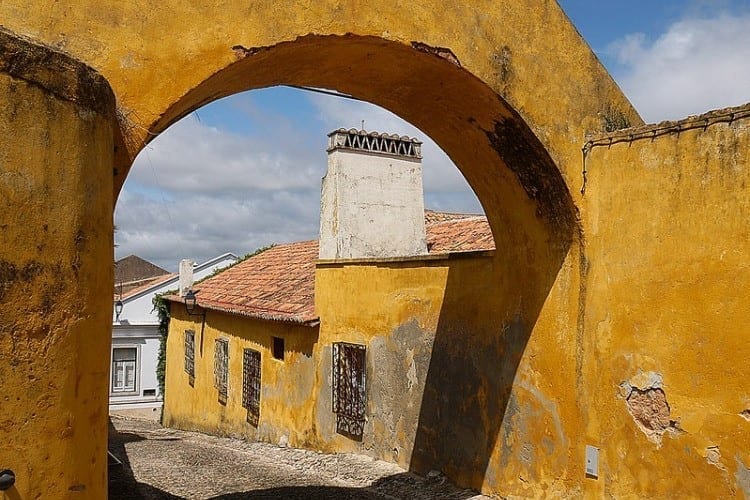
Santiago do Cacém
Historical Way: the rural interior of Alentejo
The Historical Way is the calmer face of the Vicentina Route. Less sea spray, more cork oaks; fewer seagulls, more storks. It links villages that once lived from the land and now watch colourful backpacks pass by between cork warehouses and whitewashed walls.
It is not a spectacular trail at every step, but one that wins you over gradually: wooded pastures, farmlands, quiet rivers, old mills, isolated farmsteads, villages where the bar on the main square means everything. Ideal if you prefer long walks rather than stopping every ten minutes for photos of the sea.
Stages of the Historical Way
The route is divided into multiple stages that can be linked or chosen à la carte. In practical terms, it is usually travelled between Santiago do Cacém and Cape São Vicente, through villages that sound like rural stories: Cercal do Alentejo, Odemira, São Teotónio, Odeceixe, Aljezur, Vila do Bispo…
In general, the stages:
- Range between 15–25 km.
- Are designed to be completed one per day, without rushing.
- Start and finish almost always in villages with at least some accommodation and a bar or restaurant.
- Connect with the Fishermen’s Trail at various points, allowing you to “jump” from inland to coast whenever you want to change scenery.
It works well both as a multi-day journey or weekend escape: choose two villages, check the stage that links them, and you already have your route.
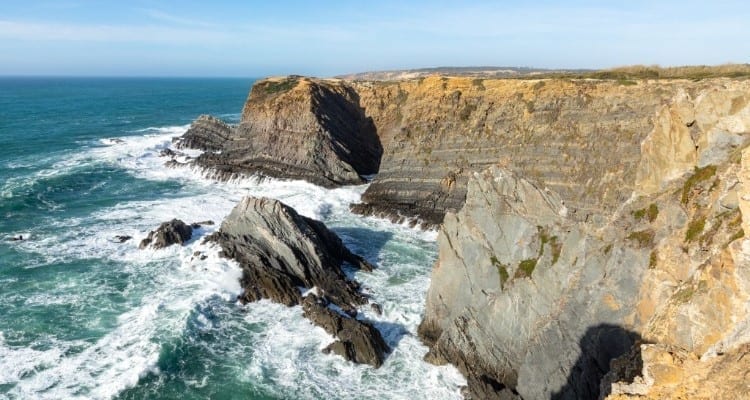
São Teotónio coast
Landscapes and difficulty
The Historical Way is not a mountain race, but it is not a stroll through a shopping mall either. Typically you will walk through:
- Dirt tracks between fields, vegetable patches and livestock farms.
- Cork oak and pine forests, where the ground is covered in leaves and the shade is welcome.
- Gentle valleys and streams, with small bridges, mills and footbridges.
- Rural areas with livestock, where you will share the trail with cows, sheep and dogs that look at you with professional curiosity.
As for difficulty:
- Gentle gradients, suitable for anyone used to walking several hours.
- Generally comfortable and stable terrain, except for occasional muddy stretches after rain.
- The main “enemy” is not the slope but the heat in hot months. A hat, water and sunscreen are essential.
If you want to start hiking multi-day routes without being an athlete, the Historical Way is an excellent school.
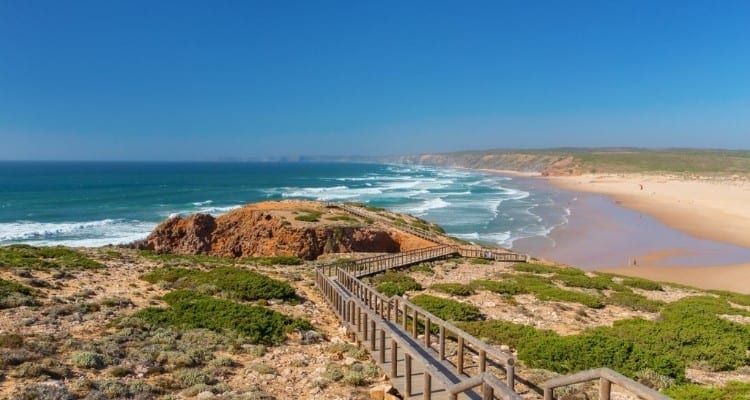
Aljezur
Fishermen’s Trail: walking along the Atlantic
Then there is its hyperactive twin, the one that looks good in every photo: the Fishermen’s Trail. A trail that sticks to the cliffs, climbs and descends dunes, looks out over solitary coves and passes through fishing villages where boats lie upside down.
Here the main protagonists are the sea and the sand. And you feel it in your legs: walking on sandy ground is harder, but the views more than make up for it. It is the kind of route where you take twice as long because you stop at every viewpoint, beach and photogenic rock.
Current stages of the Fishermen’s Trail
The Fishermen’s Trail connects small coastal towns: Porto Covo, Vila Nova de Milfontes, Almograve, Zambujeira do Mar, Odeceixe, Arrifana, Carrapateira, Vila do Bispo, Sagres…
The idea is simple:
- Stages of 10 to 22 km, always close to the Atlantic.
- Start and end points with accommodation and at least one restaurant.
- Various variants and loops to adapt distances.
Logistically, this part of the Vicentina Route is particularly pleasant if you enjoy walking and arriving by late afternoon in a village with a beach, a bar and a sunset over the ocean. It is easy to picture the end of the day: shoes full of sand, a cold beer, hair salty from the breeze, and that feeling of having spent many hours “outside”.
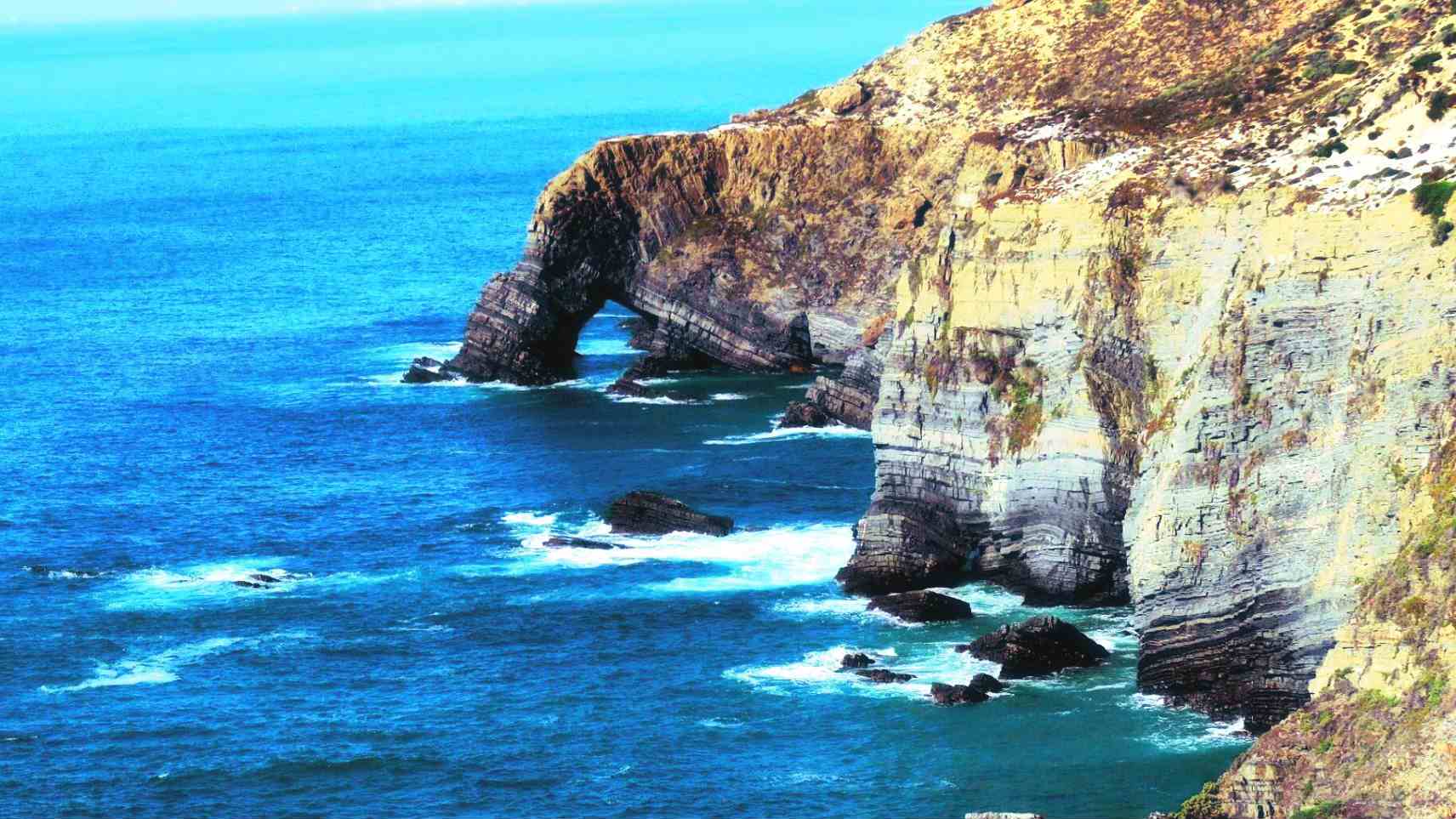
Fishermen’s Trail
Difficulty and coastal scenery
This trail is more demanding than the Historical Way, not because of steep climbs but because of the terrain:
- Long sandy stretches and dunes that strain ankles and calves.
- Short but frequent ascents and descents across ravines and coastal inlets.
- Almost constant wind, refreshing at times and exhausting at others.
In exchange, the views offer:
- Dizzying cliffs where waves crash with hypnotic rhythm.
- Endless beaches that suddenly appear at the bottom of a descent.
- Atlantic colours: deep blue, white foam, coastal vegetation, reddish or golden cliffs depending on the light.
- Fishing villages where clothes dry in the sun and restaurants announce peixe fresco on chalkboards.
If you enjoy coastal landscapes and do not mind finishing the day with tired legs, this is your trail.
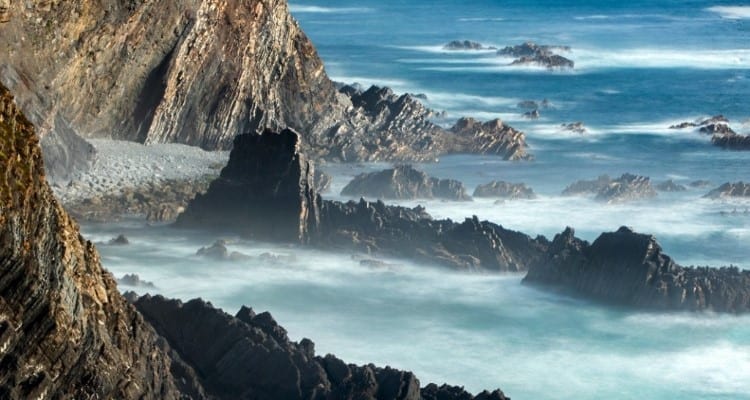
Fishermen’s Trail
Circular routes: half-day and full-day hikes
The circular routes of the Vicentina Route are perfect loops for those who want to walk without committing to long stages. They allow you to explore cliffs, ribeiras, forests and viewpoints without worrying about transport. They work very well for short trips, fixed-base stays or mixed-level groups. Some combine coast and inland, others run along rivers, and others are designed for half-day outings. Many finish in villages where it is easy to end the day on a terrace.
How to combine them with the main routes?
They are the perfect complement to the Historical Way and the Fishermen’s Trail. You can use them as an extra day to get to know a village better, as a plan B if you finish a stage early, or as a plan A if you prefer to travel without moving luggage and start each day from the same accommodation.
Can you do the Vicentina Route by bike?
Yes, but with important nuances. The Historical Way and several inland routes lend themselves well to mountain or gravel biking: dirt tracks, country lanes, few technical sections. The Fishermen’s Trail, however, is designed for walking. The stretches along cliffs and dunes are fragile, narrow and in many places incompatible with bicycles for both safety and environmental reasons.
If you want to cycle:
- Check which sections are specifically approved for bikes.
- Choose a bike with wide, resistant tyres.
- Adjust distances: what is a full stage on foot may be a short ride on a bike, so you can link several sections in a day.
In any case, the spirit of the Vicentina Route is mainly about hiking. Bikes are great companions inland, but the essence of the coastal section is best enjoyed on foot.

It is advisable to be used to cycling and train before attempting a long route
Accommodation, transport and services for hikers
One of the advantages of the Vicentina Route is that it does not run through the middle of nowhere. Towns and villages serve as support points, with a network of services that, while not extensive, is sufficient for travelling comfortably.
Along the route you will find:
- Various types of accommodation: rural guesthouses, small family-run hotels, simple hiker lodgings, and some campsites. No giant resorts, but clean beds, hot showers and hearty breakfasts.
- Restaurants and cafés: village bars with set menus, simple seafood taverns near the harbour, cafés where life revolves around the counter. Perfect for refuelling with soup, fish, grilled meat and sweets.
- Limited but useful public transport: buses connecting major villages and roads where you can easily get a taxi to skip a section or return to the start of a stage. With some planning, a car-free trip is possible.
- Taxis and luggage transfers: many villages have taxi services, and companies offer backpack transfers between accommodations. Ideal if you prefer to walk light and let your luggage travel by road.
It is advisable to book accommodation in advance during high season (spring and especially summer) and check bus schedules, which are not always daily or frequent.
Food and local culture along the route
Part of the charm of the Vicentina Route is found at the table. After a whole day walking, everything tastes better, but the local ingredients truly help:
- From the sea: goose barnacles when available, grilled sardines, sea bass (robalo), dourada (gilt-head bream), squid, and daily catch depending on what has come into port.
- From the land: hearty soups, migas, pork dishes, chouriço, cheeses from inland areas and truly crusty bread.
- Desserts: almond cakes, flans, and of course the omnipresent pastéis and other Portuguese classics.
In the villages, life still follows its traditional rhythm: older people sitting at their doorsteps, radios playing, life in the square, local festivals mixing mass, music and food stalls. The route does not only show landscapes; it also offers a window onto a calm, seaside Portugal.

Portuguese landscape
Practical safety and waymarking tips
Although the Vicentina Route is well prepared for the average hiker, it is still open nature. The Atlantic can be temperamental and the countryside deceptive. A bit of common sense and preparation make the difference between a good anecdote and a scare.
Signs and types of waymarking
Along the way you will find:
- Paint marks on posts and stones, with two parallel stripes (usually white and a colour) indicating the correct path.
- X marks where you should not continue.
- Directional posts with the name of the route and often the distance to the next point.
Even so:
- Always carry a map or GPX track on your phone and enough battery.
- Do not blindly follow other hikers: there are variantes, links and circular routes that can confuse you.
Rules and recommendations along the route
To ensure everyone continues to enjoy the route, follow these tips:
- Respect private property and livestock: if you pass through farms, close gates and fences as you found them.
- Avoid getting too close to the edge of cliffs, especially in strong winds.
- Avoid shortcuts through dunes or fragile areas: these are not just sand but delicate ecosystems.
- Carry enough water, especially on hot days. There are not always fountains along the way.
- Dress in layers and consider the wind: on the coast it can shift the perceived temperature by several degrees.

Vicentina coast
Best time to walk the Vicentina Route
The calendar here matters almost as much as your boots:
- Spring (March to May): for many, the ideal time. Green landscapes, flowers everywhere, mild temperatures, longer days. It may rain, but the light and contrasts are spectacular.
- Autumn (September and October): another excellent window. Summer heat eases, the sea still holds some warmth and the afternoon light turns golden. Perfect if you want to avoid summer crowds.
- Summer: the ocean cools you down, but the sun is unforgiving, especially on inland stages. If you can only travel in summer, start early, avoid midday hours and adjust distances.
- Winter: fewer people, a melancholic atmosphere, short days. Weather can be changeable with rain and wind, but in exchange you enjoy a calm route almost all to yourself.
Vicentina Route: an unforgettable natural and cultural experience
The Vicentina Route is not a trail for collecting checkpoints, but one to let the landscapes and villages set the pace. One day you walk among cork oaks listening to the silence of the interior. The next, waves crash beneath your feet as you walk along a cliff.
You do not need to cover the full 750 kilometres to understand it. It is enough to link a couple of stages, sit in a village bar with dusty or sandy boots, and notice that mix of tiredness and calm that only a well-walked trail gives. Later, when you are back home, the sound of the Atlantic will still echo in your mind. And perhaps, without realising it, you will already be thinking about the next time you follow the marks of the Vicentina Route, inland or by the sea.

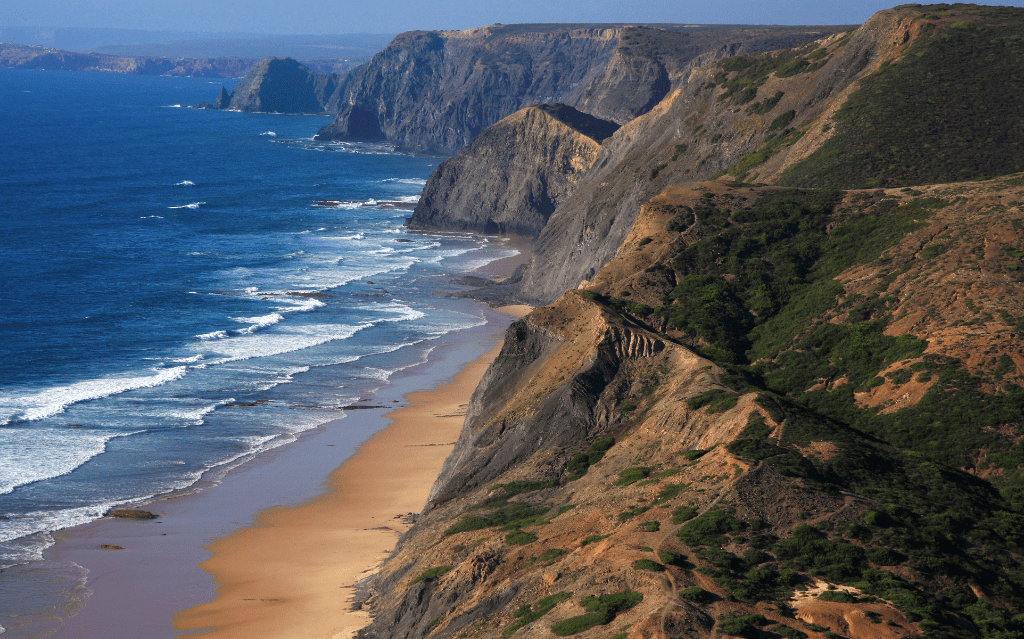










Leave A Comment